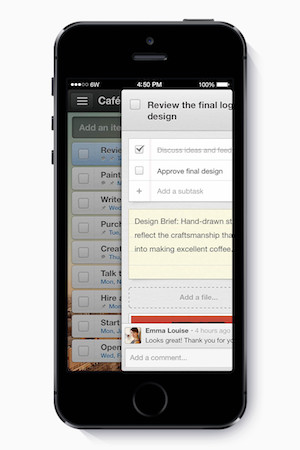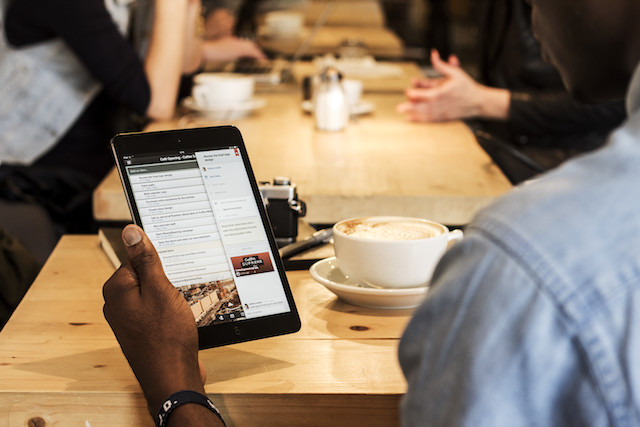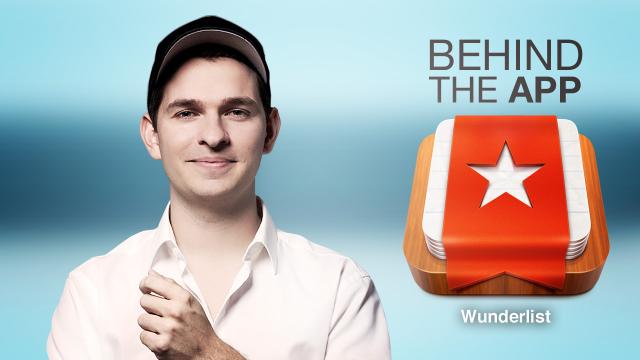We’ve been fans of the to-do app Wunderlist for years. It won us over from the start with its minimalist, easy-to-use design, and every update brought even better features. Wunderlist was also selected as Apple’s 2013 App of the Year. We caught up with founder and CEO Christian Reber to find out how one of our favourite apps came to life.

Where did the idea for the app come from? Were you trying to solve a problem you’d experienced, or did the inspiration come from somewhere else?
Before we started 6Wunderkinder, my co-founders and I were already working together as a web agency. We had multiple clients and projects on the go, and as such we were in need of a solid project management tool. We tried almost every existing solutions but we couldn’t find anything that we wanted to continue using on a daily basis.
We had very specific problems with all the solutions that were available — complexity, missing apps for mobile & desktop, no synchronisation — so we decided to just build our own product, Wunderlist. We wanted to create a product that met the needs of people just like us — a beautiful and simple app that helps you to get things done, both in your business and personal lives.
After you came up with the idea, what was the next step?
We didn’t really have an idea, but we had a specific problem to solve — and I think that was the initial success factor. Wunderlist was the result of trying to fix that problem by building a product that’s simple, intuitive, beautiful and fast.
We started building prototypes and with them we contacted various investors. We were lucky business to attract the attention of an angel investor (high net-worth individuals, willing to invest their personal money to build new businesses) and two months later we launched Wunderlist for Mac and Windows, followed by iPhone, iPad, web, and Android. Because of the success we had during the launch, international investors contacted us, and we were then able to close an investment with Atomico (part of the team behind Skype) to ensure on the on-going success of Wunderlist.
How did you choose which platforms to target and which to ignore or wait on?
In the beginning we didn’t. We had the clear goal to support as many platforms as possible, even Blackberry, Linux and Windows Phone — we had an app for almost every platforms available.
We honestly didn’t realise at that time, that having a large amount of apps slows down the development time enormously. If you do one change in your architecture, it affects all your client applications — completely different to just having one web application. So in order to become faster, we then decided to only support the fastest-growing and most popular operating system — iOS, OS X, Android, Windows — and web (that includes Chrome OS).
Currently we are working on a big rewrite of Wunderlist — Wunderlist 3. The update will not only support more platforms (we’ll have some exciting announcements planned for the Windows platform soon), we have also completely rethought the entire product, both from a design and technology perspective.
At the beginning of this process we asked ourselves, how can we continue to build high-quality software, while supporting as many platforms as possible. Within the next months, we’ll release the new version, which will be a huge step forward for us and will bring Wunderlist into everyone’s daily life. We are talking a brand new design, a much lighter interface, real-time synchronisation, and finally, a public API. We don’t want Wunderlist to just be to-do app anymore.
What was your biggest roadblock and how did you overcome it?
Oh, that’s easy. Focus was by far (and regularly is) the biggest roadblock. I think that also holds true for most startups and businesses. As soon as you have success, you try to grow it by doing more and more, in our case, building more features, supporting more platforms, we’ve even tried building more products (some of you may remember Wunderkit). I know “lack of focus” sounds extremely obvious, but if you work every day on one product, it actually becomes really hard to focus on the important things, only.
What’s more when your team grows (we’re now more than 50 people), it becomes significantly harder to connect all the small pieces to focus on building an extremely polished product. As more and more really skilled and ambitious people join everyone wants to contribute in their own way (which often means building their own features). So, we constantly need to refocus as a team to make sure we all deliver a consistent product experience across all platforms.
Without a doubt launching that second product, was my biggest roadblock, but also a the most important learning I’ve ever had. Every time we struggle with anything, that experience helps me to refocus and rethink what’s actually important.
What was launch like for you?
That’s a great question. I often compare building a product, with building a football club. You choose your players, you train hard, you join a competition, and then you win or lose. That’s the same for a company, you hire your team, you work extremely hard to build the first version, you launch (which is usually the most stressful time), and then you are either successful or not.
Launching a product is the most exciting time, it’s extremely energizing and motivating (if things go right). But it’s also extremely intense, stressful, and tough. Football clubs have fans, startups have fans. What you see from the outside, rarely reflects what’s actually going on inside… but, to be precise, I love it. I truly love designing products and developing apps.
How do you handle user requests and criticisms effectively?
We have a feature request forum, where our community actively submits their ideas for improving Wunderlist. The feature requests are then put to the entire community to cast their vote, so we can get a quick overview as to what it is the majority of our users want us to build. These feature requests then become part of the product roadmap.
We also read every single email, tweet and Facebook message that is sent to us. I think we have a pretty good sense what our users expect from us, and I’m confident that Wunderlist 3 will reflect what our users want.

Now, how do you split time between developing new features and managing existing ones?
Right now, we are 100 per cent focused on delivering a major update with Wunderlist 3. We view Wunderlist 3 as the new core of Wunderlist, laying the foundations to surprise our users regularly with new exciting features.
The way we manage new features is simple, we always choose the most important one, and launch it. Then we pick the next, and the next, quite obvious. Existing ones are much harder, because it’s more about polishing, or changing architecture. Changing existing features usually requires much more work, and the immediate outcome is unclear. If we see that a feature is not working out the way we wanted, then we change it. But we constantly polish every feature we have in Wunderlist.
What advice would you give to others that want to take on a similar project?
In general, fix your own problem. That always worked for me, I only build products I desperately want to use myself. But also, it depends on the background of the person I’m giving advice to. I’m a hybrid of a programmer and a designer, and that helps me to understand and connect both worlds.
Building products requires passion and patience, and if you don’t enjoy it, don’t do it. If you decide to do it, than always try to first build the simplest version of a product you can. Be brutal in prioritization of features and simplification of design. Then build a product that adds value to peoples life, and ignore trends.
Lifehacker’s Behind the App series gives an inside look at how some of our favourite apps came to be — from idea to launch (and beyond).

Comments